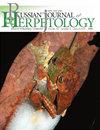Morphometrics, Habitat and Breeding Activity of Asian Common Toad, Duttaphrynus melanostictus, in Pakistan
IF 0.9
4区 生物学
Q3 ZOOLOGY
引用次数: 0
Abstract
The scientific data on ecology of amphibians from Pakistan are scarce. Asian Common Toad (Duttaphrynus melanostictus) is widely distributed in South Asia, and has been introduced outside its range causing severe ecological problems. We gathered data on morphometrics, habitat and breeding activity of the species in its western edge, North Punjab, Pakistan, of the range. The morphometric measurements of Asian Common Toad showed that the males were 49 ± 3.4 mm in snout vent length while the females were 58 ± 5.5 mm. Of the 13 measurements tested, the factor analysis produced five (head width, forelimb length, femur length, width of upper eyelid and foot length) significant measurements (r 0.80) for male while six (snout-vent length, head width, head length, greatest tympanum diameter, forelimb length, length of tarsus and foot) for female. The substrate of the habitat of Asian Common Toad was recorded as muddy to stony; water with neutral to slightly alkaline pH; dominated by herbs: Cannabis sativa, Parthenium hysterophorus; shrubs: Dodonaea viscosa, Lantana camara; grasses: Cynodon dactylon, Dactyloctenium aegyptium; and hydrophytes Alternanthera sessilis and Centella asiatica. The mean air and water temperature (day) during the breeding period were 27 – 30.5 and 25 – 28.5°C, respectively. The toad species laid eggs in small sized pools with lentic to slow-moving water with the mean depth of 32 – 64 cm. The males were more abundant than females (2.14♂:1♀) at the breeding sites. The advertisement call was of 9.3 ± 0.80 sec duration with a single note and 49.5 ± 6.5 nodes, –7.45 ± 0.95 average amplitude, 776 ± 51.8 Hz minimum frequency and 7011 ± 1680 Hz maximum frequency.巴基斯坦亚洲蟾蜍形态计量学、生境及繁殖活动
关于巴基斯坦两栖动物生态学的科学数据很少。亚洲蟾蜍(Duttaphrynus melanotictus)广泛分布于南亚,已被引入其范围外,造成严重的生态问题。我们收集了该物种在其西部边缘,巴基斯坦北旁遮普的形态计量学,栖息地和繁殖活动的数据。对亚洲蟾蜍的形态测量表明,雄性蟾蜍的口部长度为49±3.4 mm,雌性蟾蜍的口部长度为58±5.5 mm。在测试的13项测量中,因子分析产生了男性的5项显著测量(头宽、前肢长、股骨长、上眼睑宽度和脚长)(r 0.80),而女性的6项显著测量(口长、头宽、头长、最大鼓室直径、前肢长、跗骨长和脚长)。据记载,亚洲蟾蜍栖息地的基质为泥质到石质;pH值为中性至微碱性的水;以草本植物为主:大麻、巴台南;灌木:杜鹃,山楂;禾草类:短爪草、埃及短爪草;水生植物互花草和积雪草。孳生期平均气温27 ~ 30.5℃,日平均水温25 ~ 28.5℃。蟾蜍在平均深度为32 - 64厘米的小池中产卵,池中水流缓慢或缓慢。在繁殖地,雄鼠数量多于雌鼠(2.14♂:1♀)。广告呼叫时长为9.3±0.80秒,单音符,49.5±6.5个节点,平均幅值为-7.45±0.95,最低频率为776±51.8 Hz,最高频率为7011±1680 Hz。
本文章由计算机程序翻译,如有差异,请以英文原文为准。
求助全文
约1分钟内获得全文
求助全文
来源期刊

Russian Journal of Herpetology
ZOOLOGY-
CiteScore
1.70
自引率
0.00%
发文量
29
期刊介绍:
Russian Journal of Herpetology is an international multi-disciplinary journal devoted to herpetology. Russian Journal of Herpetology accepts original papers on ecology, behavior, conservation, systematics, evolutionary morphology, paleontology, physiology, cytology and genetics of amphibians and reptiles.
Types of Contributions:
-original papers
-invited or contributed reviews on specific topics
-short communications on topics of immediate interest, new methods and ideas in progress
-notices of meetings, symposia, and short courses
-book reviews
 求助内容:
求助内容: 应助结果提醒方式:
应助结果提醒方式:


